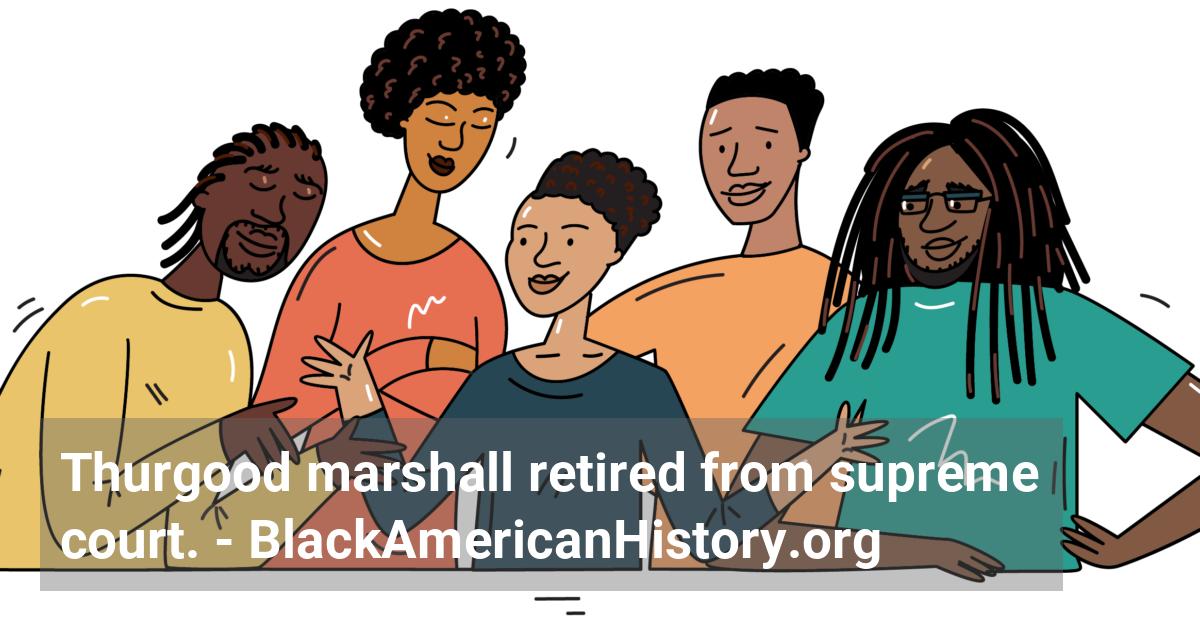Home / Full timeline / Supreme Court Justice Thurgood Marshall announces his retirement, decrying the conservative direction that the nation’s highest court is taking.
 Supreme Court Justice Thurgood Marshall announces his retirement, decrying the conservative direction that the nation’s highest court is taking.
Supreme Court Justice Thurgood Marshall announces his retirement, decrying the conservative direction that the nation’s highest court is taking.
1991 (Jun 27)
Supreme Court Justice Thurgood Marshall announced his retirement, decrying the conservative direction that the nation's highest court was taking. The eighty-three-year-old Marshall, the first Black to serve on the Supreme Court, contended that "power, not reason, is the new currency of this Court's decision-making." Failing health and a rigorous court schedule prompted him to retire after serving on the Court for twenty-four years. Marshall was born in Baltimore, Maryland, in 1908. He attended Lincoln University with the hopes of becoming a dentist. After graduating in 1930, Marshall decided to change his career path by enrolling in Howard University Law School, where he graduated at the top of his class in 1933. He entered private practice and a year later became counsel for the Baltimore branch of the NAACP; in 1938, Marshall was appointed chief legal officer of the organization. He later served as director-counsel of the NAACP Legal Defense Fund. In this capacity, Marshall played a crucial role in the fight to dismantle segregation in the United States, leading the legal team that argued before the Supreme Court in the landmark case Brown v. Board of Education of Topeka, Kansas in 1954, in which the high Court ruled unanimously that racial segregation in American public schools was unconstitutional. In 1961, President John F. Kennedy appointed Marshall judge of the Second Circuit Court of Appeals, making him the second Black jurist to serve on a federal appeals court. Marshall made history in 1965 when President Lyndon B. Johnson named him solicitor general of the United States, and again in 1967 when President Johnson appointed him to the Supreme Court. Marshall, a man of fierce pride, understood his role in American history. As a liberal member of the Supreme Court, he was often the influencing factor that kept his fellow justices mindful of the less fortunate. During his tenure on the Court, Marshall earned a reputation for his outspoken interpretations of the First Amendment to the Constitution and for his passionate attacks on discrimination. Among the Supreme Court decisions Marshall authored are Amalgamated Food Employees Union v. Logan Valley Plaza (1968) and Dunn v. Blumstein (1972). Marshall "brought a diversity of viewpoints to the Court," noted J. Clay Smith, Jr., professor of constitutional law at the Howard University Law School. "Justice Marshall provided the Court the point of view of the poor in this country—Black and White. I'm sure his experience and knowledge of poverty and segregation influenced the Justices, conservative and liberal alike."
References:
- • Hornsby, Alton. Chronology of African-American History: Significant Events and People from 1619 to the Present. Detroit: Gale Research, 1995.
